
Student Writing Samples | Opinion Writing

Opinion Writing- Grade 5 - Autumn
Read Time 3 mins | Dec 8, 2021 4:49:12 PM | Written by: Toolbox
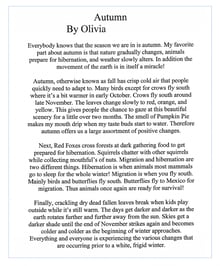
Informational/Opinion Writing Grade 5 Sample Autumn
Feedback for Improvement
Topic: Autumn - my favorite season Main Reason#1: changes in nature Main Reason #2: animals prepare Main Reason #3: weather changes
What worked:
- Organization: This piece includes an introduction, three main reasons and a conclusion. The student clearly understands the organization and author’s purpose of informational/opinion writing.
- Main Ideas: There are three main reasons, however, the nature of the main reasons is overlapping. See the prescriptive lessons below for additional commentary.
- Elaboration: There is some evidence of the detail generating questions. In paragraph two the author writes, “The leaves change slowly to red, orange, and yellow. This gives people the chance to gaze at this beautiful scenery for a little over two months.” There are additional sentences that are descriptive in nature, however they are extraneous from the main reason. In some instances, the descriptive detail does not go on to include “Why is it important?” so it reads like a description for the sake of description.
- Sentence Variety/Word Choice: The student uses interesting sentences. For example, “Therefore autumn offers us a large assortment of positive changes.” Another example, “Thus animals once again are ready for survival!”
Feedback with Prescriptive Lesson:
CHOOSE a Focus Skill: What skill will make the biggest impact for this writer?
Broad Yet Distinct Main Ideas/Reasons: This piece of writing displayed some overlapping of main reasons. This student would benefit from a deep dive into this skill. When looking at the details that support each main reason, the reader can easily see that there are details that could fit into any one of these main reasons. For example, in the first main reason paragraph the author writes, “Many birds except for crows fly south where it’s a bit warmer in early October.” This detail could easily fit into the paragraph all about how animals prepare. Another example of the overlapping nature of the main reasons is in main reason three where the student writes, “The days get darker and darker as the earth rotates further and further away from the sun.” This detail is really about changes in nature. Because of this overlapping nature, the reader is left to wonder what this piece is really all about.
All lessons in this section need to be taught with an emphasis on Lesson 3 Pick, List, and Choose. The importance of choosing broad yet distinct main ideas/reasons affects every other part of the writing. Once you’ve established a number of main ideas/reasons through the pick, list, choose process, then it’s imperative that you look at those that could potentially overlap and make sure students choose main ideas/reasons that are distinct from one another.
- Section 2 Lesson 3: Pick, List, and Choose
- Section 2 Lesson 5: Main Ideas - Don't Overlap Them!
- Section 2 Lesson 6: Main Ideas/Reasons - Broad or Too Narrow?
This student obviously understands the structure of informational/opinion writing but needs direct instruction in choosing main ideas/reasons that are distinct. The fact that there is some powerful word choice, interesting description, and sentence variety is overshadowed by the overlapping nature of the main ideas/reasons.
Recommended Resources
- Empowering Writer's Methodology
- Informational & Opinion Writing Guide for Grade 5


Teaching with a Five-Paragraph Essay Example
Looking for a five-paragraph essay example? Look and listen in as a fourth grade teacher models this strong writing structure for her students.
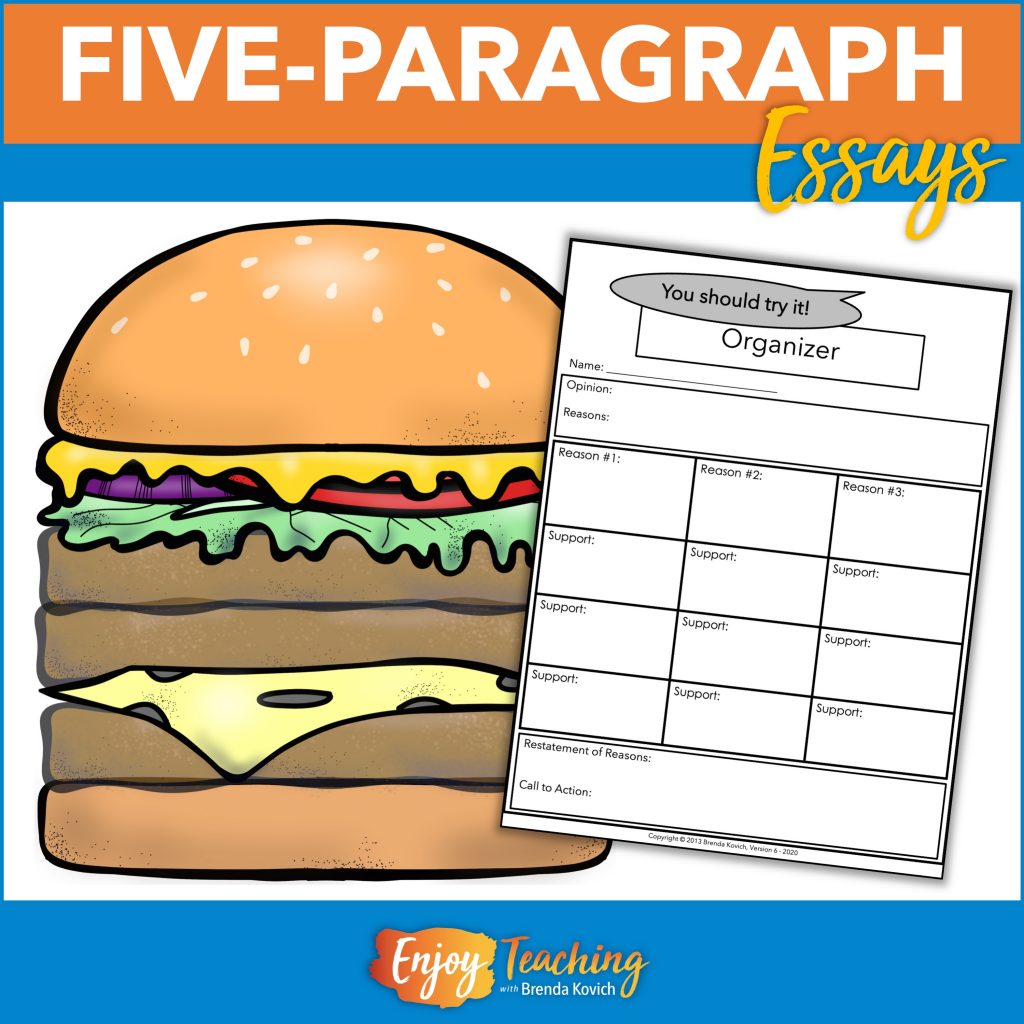
Ms. Sneed Grades Her Kids’ Paragraphs
As our favorite fourth grade teacher graded her class’s latest paragraphs, she let out a satisfied sigh. First they tackled paragraph structure. Then they learned to elaborate. Additionally, they improved their writing by varying sentences and using transitions. Now that they had the writing strategies down, her kids were ready to scaffold from one paragraph to the five-paragraph essay .
Purposefully tackling each genre of writing – then scaffolding from shorter to longer – was sure to work for her.
A Five-Paragraph Essay Example
Ms. Sneed turned and opened her laptop. With just a few clicks, she found it. Her favorite prompt, You Should Try It , asked kids to persuade others to try an activity – in five paragraphs.
Teaching Paragraph by Paragraph
The following Monday, Ms. Sneed stood in front of her class. “Today,” she said, “you will learn how to write a longer essay.”
Several kids looked a little unsure, but their teacher continued. “For now, I’ll take you through a five-paragraph essay example. That should ease your concerns.”

First Paragraph
Ms. Sneed projected a sample. “The first paragraph, or introduction, includes a thesis statement and supportive factual reasons.”
With the mention of a new term, thesis statement , more kids looked uncomfortable. Some squirmed in their seats.
“Now I know the term thesis statement is new, but no worries! You know it as a topic sentence. However, the thesis is the main idea of a multi-paragraph composition.”
The teacher read the paragraph aloud. “Can anyone pick out the thesis for this persuasive essay?” she asked.
One student slowly raised his hand. “Wouldn’t you like to try water skiing?”
“Yes! Although it’s written as a question, this sentence offers an opinion. Furthermore, the entire essay supports this thesis. Can you find the author’s three supporting reasons?”
Using the five-paragraph essay example, the class soon established the supporting details too: improving health, impressing friends, and teaching them to ski.
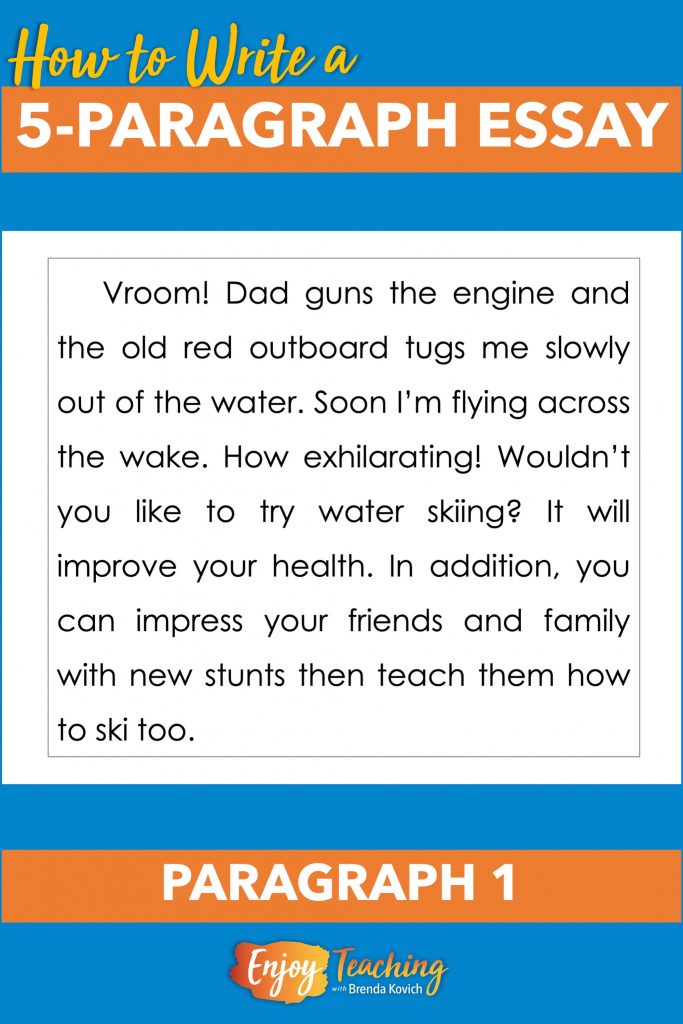
Second Paragraph
“Now let’s look at the second paragraph,” Ms. Sneed said.

“You identified one of the main details as health. As you can see, this paragraph expands on that reason.”
“That’s just what we were doing with one paragraph,” piped up a girl in the back row.
“Um-hm. True. But writing in five paragraphs gives you more room to elaborate.”
The kids seemed to relax in their seats. This wasn’t so bad after all.
Third Paragraph
With no further ado, she pulled up the third paragraph. “See, paragraph #3 discusses the second main supportive detail.”
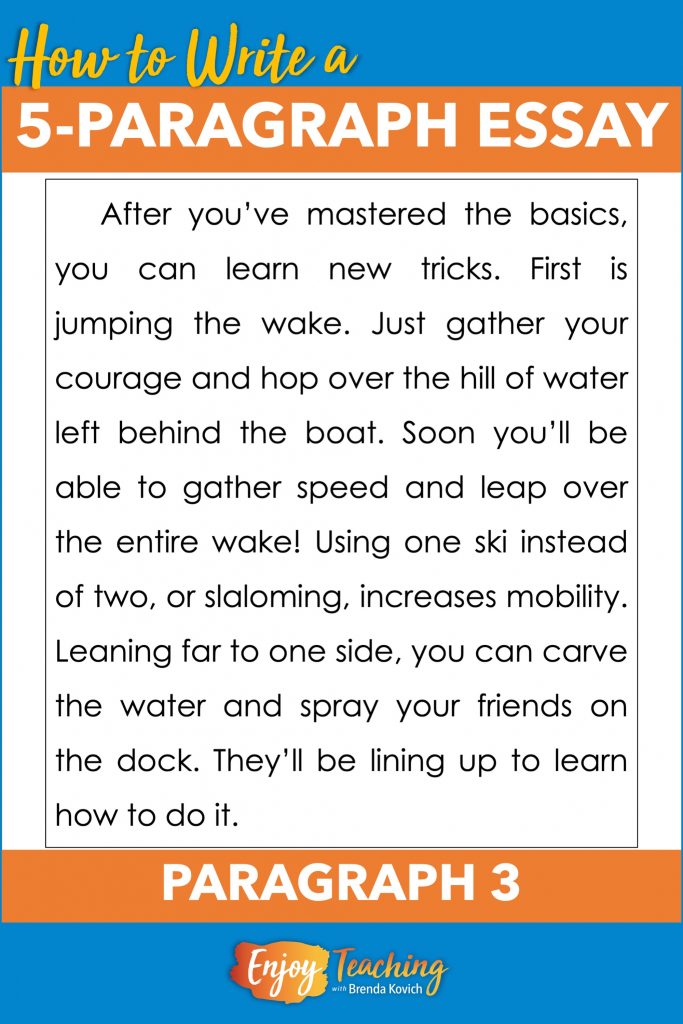
After they read the paragraph aloud, Ms. Sneed asked, “Who can find the topic sentence of this paragraph?”
“Isn’t it the first sentence?” said a boy with purple glasses.
Ms. Sneed nodded. “Easy peasy. The main idea of this paragraph, as we said before, is the second reason.”
Fourth Paragraph
For the fourth paragraph, Ms. Sneed tried a new tactic. “Okay, think-pair-share! Find the the topic sentences and smaller details that support it.” Her students knew what this meant. Immediately, they turned to their seat partners and began to discuss.
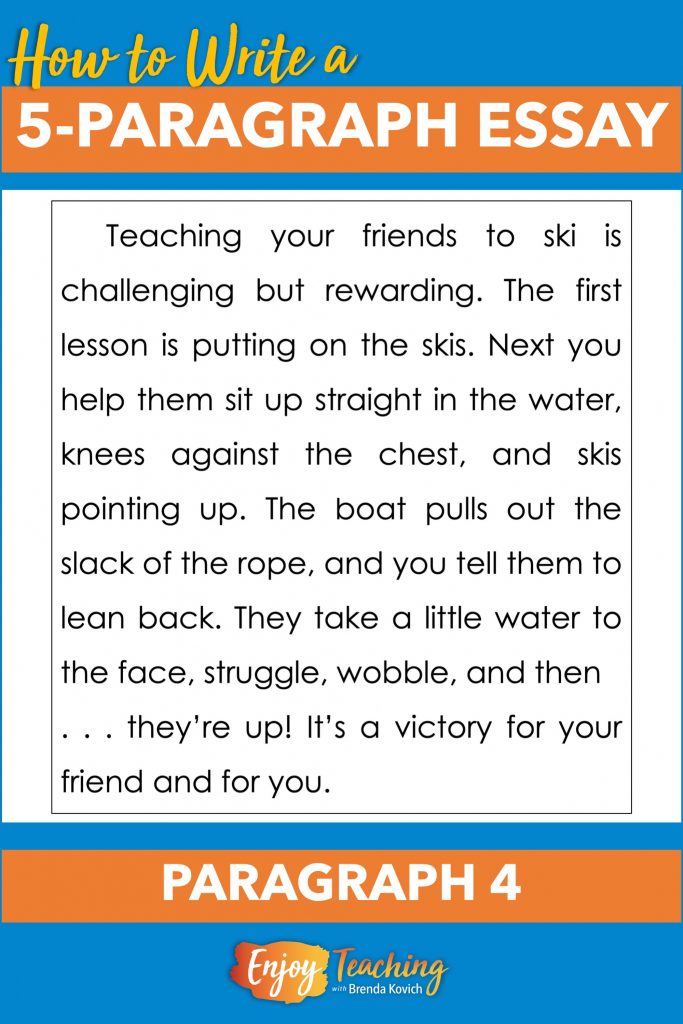
After a few minutes, groups began to share:
“The first sentence is the topic sentence again,” said the first spokesperson.
“And the details are the steps in teaching,” said the second.
“Ahh, a sequence paragraph inside a five-paragraph persuasive essay,” Ms. Sneed remarked. That famous teacher smile spread across her face.
Fifth Paragraph
“Here we have the final paragraph, or conclusion,” the teacher continued.

After she read the paragraph aloud, Ms. Sneed pointed out the restated thesis statement and details. “It’s a repeat of the first paragraph in different words.”
A Five-Paragraph Essay Example – and a Hamburger!
Quickly, strode toward the board. She picked up a marker and sketched a hamburger with three patties. “Does this look familiar?”
Everyone smiled and nodded. Ms. Sneed’s favorite analogy for an writing a paragraph !
“We just used this again,” their teacher said. “The top bun is the first paragraph. It introduces the main idea with a thesis statement and supporting details. The first hamburger patty explores the first detail; the second, the second; and the third, the third! Finally, the bottom bun wraps it all up with a restatement of the thesis and details. This helps you write, as well as find the main idea and supporting details .”
“It’s just a giant version of the paragraph,” said a small girl in the front corner.
“Yep,” replied Ms. Sneed. “Not hard at all – if you know what you’re doing. Over the next few months, we’ll write more of these essays in our ELA block . Then you’ll feel even more confident.”


IMAGES
VIDEO